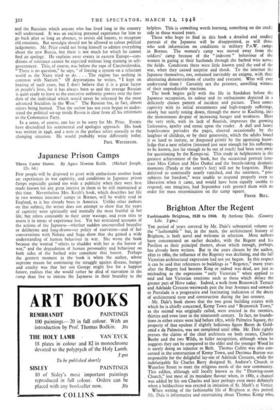Brighton After the Regent
Fashionable Brighton, 1820 to 1860. By Anthony Dale. (Country Life. 2 gns.)
THE period of years covered by Mr. Dale's substantial volume on the " fashionable " but, in the main, the architectural history of Brighton, is both novel and welcome in selection. Most authors have concentrated on earlier decades, with the Regent and his Pavilion as their principal themes, about which enough, perhaps, has already been written. But in the years chosen by the author, 182o to 186o, the influence of the Regency was declining, and the full Victorian architectural expression had not yet begun. In this respect it can be said that references to buildings as " Regency," many years after the Regent had become King or indeed was dead, are just as misleading as the expression " early Victorian " when applied to mid and late Victorian erections such as those which deface the greater part of Hove today. Indeed, a walk from Brunswick Terrace and Adelaide Crescent westwards past the four Avenues and onwards to Portslade is a progressive and fascinating indication of the decay of architectural taste and construction during the last century.
Mr. Dale's book shows that the two great building estates with which he is chiefly concerned, Kemp Town and " Brunswick Town," as the second was originally called, were erected in the twenties, thirties and even later in the nineteenth century. In fact, no founda- tions in either estate were laid before 1825, while Palmeira Square, the property of that opulent if slightly ludicrous figure Baron de Gold- smid e da Palmeira, was not completed until 1860. Mr. Dale rightly presses the claims of the chief architects on both estates, Charles Busby and the two Wilds, to fuller recognition, although when he suggests they can be compared to the elder and the younger Wood he is surely doing an injustice to Bath. Thomas Cubitt was also con- cerned in the construction of Kemp Town, and Decimus Burton was responsible for the delightful lay-out of Adelaide Crescent, while the indefatigable Sir Charles Barry designed St. Andrew's Church in Waterloo Street to meet the religious needs of the new community. This edifice, although still locally known as the " Drawing-room Church," lost most of its mundane flavour when, in 1882, a chancel was added by his son Charles and later perhaps even more definitely when a baldacchino was erected in imitation of St. Mark's at Venice.
When writing of the fashionable life of Brighton at this period, Mr. Dale is informative and entertaining about Thomas Kemp who,
not content with building, for his own use, a mansion supposedly to the exact measurements of Solomon's Temple, known as " Kemp's Folly," was also one of the founders of a new evangelical sect for which he commissioned Amon Wilds to build Trinity Chapel in Ship Street. Owing, however, to " the awful extremes of error " practised by the leaders of this sect, it did not flourish for long, and the chapel was eventually converted for the more conventional usages ct the Established Church. Amongst ether celebrities Mr. Dale mentions Sir Albert Sassoon who, on relinquishing his lucra- tive business in India, took No. I Eastern Terrace in 1876. He also built behind his house an astonishing mausoleum of oriental design to receive his body and those of his successors. This exotic pile, fortunately still in existence, looks almost as though it had floated away from the main body of the Pavilion and become rooted in the less dignified surroundings of Paston Place.
There is much solid and interesting information in Mr. Dale's work, and it should prove a valuable book of reference for Brighton in that period. There is, however, some unnecessary repetition about the activities of well-known people, and in some cases their connections with Brighton were so slender that it would have been an economy in space not to have mentioned them at all. Although there are some ninety illustrations, some of singular interest, the photographs of contemporary Brighton and Hove are almost without exception disappointing, as no use whatever is made of cloud effects which are such a familiar feature of the Brighton landscape. It is also unexpected that the only picture of a royal personage connected with Brighton should be that of the Duchess of Fife and her family, since the sole activity of the Duchess recorded by Mr. Dale was the redecoration of her house, No. 1 Lewes Crescent, previously occupied by the sixth and " bachelor " Duke of Devonshire. Here, it appears, she smothered the ceiling of the drawing-room with a thick brown lincrusta paper, as well as the walls which previously had been painted with silvery trees and ornamented with porcelain birds



































 Previous page
Previous page